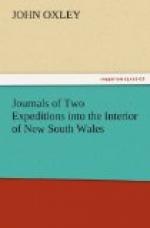spread over it: the channel also appeared deep
leading into the inner haven. There is plenty
of fresh water in swamps, on almost every part of
the shore on which we were. The higher lands abound
with good timber, the points nearest the sea being
covered with Banksia integrifolia, of large dimensions,
fit for any kind of boat timber. It is high water
full and change at ten minutes after nine, and the
tide appears to rise between four and six feet.
From a point near the entrance, several bearings were
taken; and we also saw another large lake, or perhaps
fresh water lagoon, Under the southernmost of the Three
Brothers. A sunken rock was also discovered off
to sea, lying upwards of two miles from the next point
southerly of us, and bearing S. 5. W.: a
deep clear channel lies between it and the shore.
At one o’clock we departed, and by sunset had
accomplished near fourteen miles of our journey.
We saw the large lake under the Brothers from a high
point on the coast very clearly, and found that on
the north it was bounded by the North Brother, and
separated from the sea by a strip of low marshy land
about three quarters of a mile wide. This lake
I think is a fresh water one: it was named Watson
Taylor’s Lake. The country west and southerly
of the Brothers consisted of low forest hills; and
a range of hills of moderate height, the entrance
of which bore west-south-west distant twenty or twenty-five
miles, ended near Cape Hawke, the country being to
that range very low with marshes. A strip of sandy
land half a mile wide bounds the shore, on which is
good grass and water. On the beach where we halted
we found a small boat nearly buried in the sand, but
quite perfect. It had belonged to a Hawkesbury
vessel, belonging to one Mills, which had been lost
some time ago, and the crew of which perished.
We halted on the beach, the South Brother bearing
W. 32. N., and the Reef N. 53 1/2. E., and
which we now saw extended near three quarters of a
mile north and south, and lying two marine miles from
the shore. It appears dangerous, since in fine
weather (as to-day) the north part of the reef only
breaks occasionally.
October 19.—Proceeded on our journey up
the coast: on attempting to cut off a point of
land which would have saved us a distance of some miles,
we found that the low part of the country was an entire
fresh water swamp, interspersed with thick barren
brushes, in all respects resembling the country between
Sydney and Botany Bay. We therefore returned again
on the beach, and crossing nearer to the point in
question found the remains of a hut, which had evidently
been constructed by Europeans, the saw and axe having
been employed on it. About four miles farther
on the beach, towards Cape Hawke, our progress was
stopped by a very extensive inlet, the mouth of which
was nearly a mile wide. It was near high water,
and the sea broke right across with tremendous violence,
affording us little hope, circumstanced as we were,




